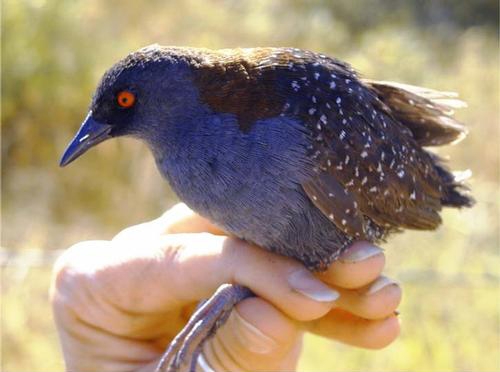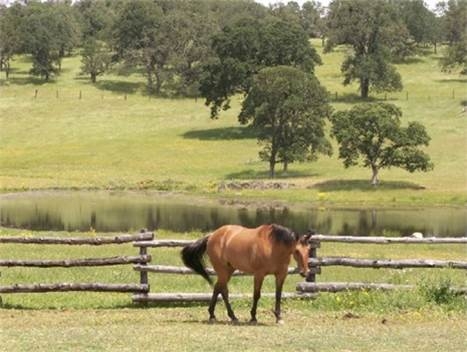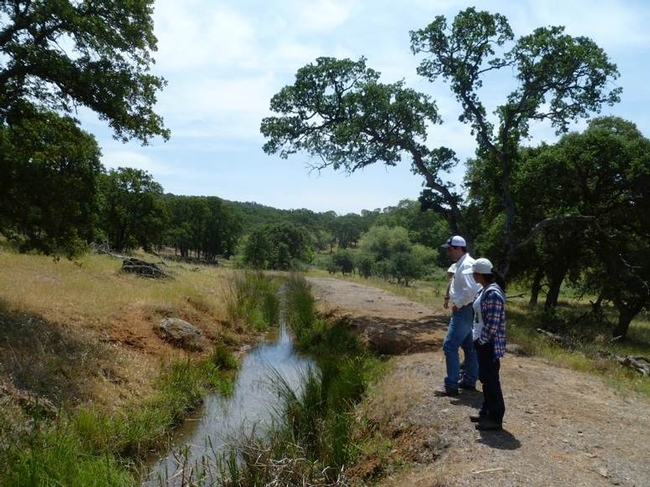California black rail likes leaks
While Californians are tightening their pipes to conserve water during this fourth year of drought, the California black rail might say, “Let it leak,” if it could speak.
The rare bird species makes its home in marshes created in large part by leaky pipes, stock ponds, irrigation tailwater and unlined canals. Even the springs that support some habitat may rely on water flowing from leaky canals. In 1994, UC Agriculture and Natural Resources scientists found the small, red-eyed bird with the black breast and speckled black feathers at UC ANR's Sierra Foothill Research and Extension Center. Since its discovery, a group of scientists have been exploring the effects of water management and climate change on the bird in Sutter, Butte and Yuba counties.
California black rails, which can be heard more often than seen, largely depend on humans and irrigated agriculture to provide the shallow flowing water they use for habitat.
Because most of the rangeland in the area is privately held, and includes irrigated pasture for livestock, Lynn Huntsinger, professor in the Department of Environmental Science, Policy and Management at UC Berkeley, wondered if property owners would be willing to maintain wetlands to support wildlife.
With the help of UC ANR Cooperative Extension advisors Glenn Nader and Roger Ingram, Huntsinger conducted a survey of 1,000 landowners in the three counties.
Property owners responding to the survey said the primary reason for maintaining ponds and wetlands is to reduce wildfire risk, but they also like the birds and wildlife that are attracted by wet areas. However, Huntsinger worries that the “accidental wetlands” may dry up as the drought increases the pressure on people to conserve water by fixing leaks and replacing canals built during the 19th century Gold Rush with pipes.
Most of the farmers and ranchers buy water from a water district so Huntsinger sees working with water districts as a key to the sustainability of wetlands for wildlife.
“Water is going to be more expensive and harder to access given the trends in weather and population demand,” she said. To predict how long landowners will continue to maintain wetlands if water prices rise, Huntsinger is working with Jose Oviedo, an environmental economist in Spain.
More and more, she says, it seems that we are facing tradeoffs between “goods”— saving water is good and preserving wildlife habitat is good. “We need flexibility and adaptation rather than all or nothing choices. After all, we are creating the future landscape of California,” Huntsinger said.
Huntsinger's study is just one facet of a California black rail study that involves scientists with different kinds of expertise.
Steve Beissinger, professor in the Department of Environmental Science, Policy and Management at UC Berkeley, has been studying black rail behavior for years and continues to monitor how many sites in the Sierra foothills the small birds use as habitat.
Norman Miller, a Lawrence Berkeley Laboratory hydrologist, is developing models to understand the water dynamics and sustainability of the wetlands habitat.
Marm Kilpatrick, assistant professor in the Department of Ecology and Evolutionary Biology at UC Santa Cruz, studies how concern about mosquito-borne West Nile virus may affect landowners' decisions to maintain wetlands.
“It is a novel ecosystem, offering habitat engineered by people and their livestock that happens to offer the black rail what it needs,” Huntsinger said. “We just don't know enough about conservation in this kind of situation. Managing traditional landscapes is common in Europe, but rare in the United States.”
For more information about the California black rail, see the California Agriculture article “California black rails depend on irrigation-fed wetlands in the Sierra Nevada foothills.”
Below, UC Berkeley graduate student Nathan Van Schmidt describes research at UC Sierra Foothill Research and Extension Center on how the rails cope with drought, seasonal hydrology regimes, and the rescue effect.
An initiative to maintain and enhance sustainable natural ecosystems is part of UC Agriculture and Natural Resources Strategic Vision 2025.




